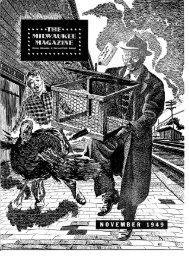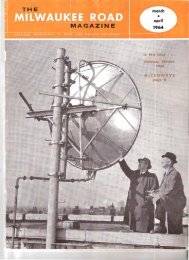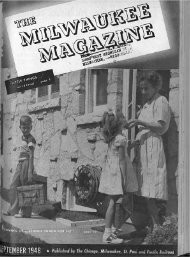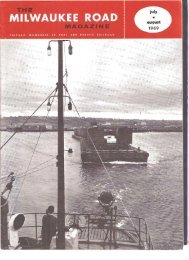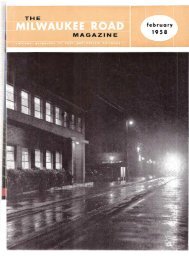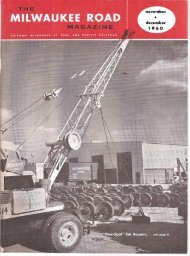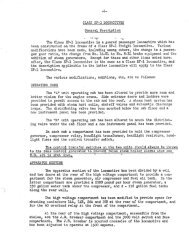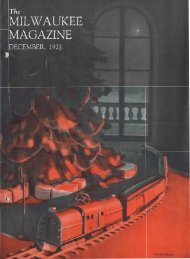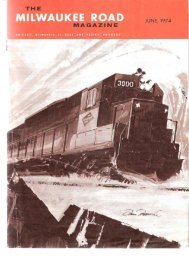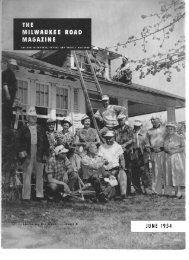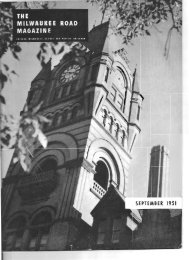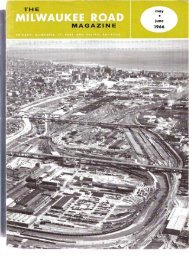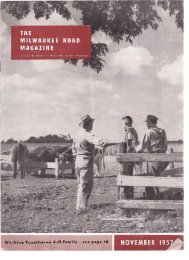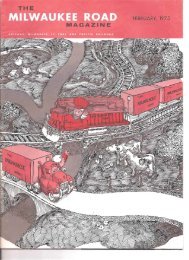March-April, 1961 - Milwaukee Road Archive
March-April, 1961 - Milwaukee Road Archive
March-April, 1961 - Milwaukee Road Archive
You also want an ePaper? Increase the reach of your titles
YUMPU automatically turns print PDFs into web optimized ePapers that Google loves.
A brief account of the highlights of The <strong>Milwaukee</strong><br />
In the face of a general recession which sharply reduced<br />
railroad revenues in 1960, The <strong>Milwaukee</strong> <strong>Road</strong> successfully<br />
effected a balanced reduction in expenses and builr<br />
securely on a strong foundation for the future. Improvements<br />
were introduced to provide the public with the best<br />
in service, and the property was maintained in condition<br />
to take full advantage of the anticipated business upturn.<br />
The actual extent of the decline in earnings and revenues<br />
came as a disappointment. Revenues dropped $11,678,923<br />
to $230,362,902 in 1960 from $242,041,825 in 1959. Net<br />
income was $1,323,063 last year compared with $5,875,176<br />
in the preceding year.<br />
The outlook for <strong>1961</strong> is more favorable. There is already<br />
indication that housing starts will be up, and we<br />
can reasonably expect mOre normal movements of lumber<br />
and other forest products. In this freight category, which<br />
is of major importance to The <strong>Milwaukee</strong> <strong>Road</strong>, Our 1960<br />
revenues were down 16.2 per cent from 1959.<br />
Other unfavorable factors in 1960 were the slump in<br />
the iron and steel industry, resulting in decreased revenues<br />
from the smaller traffic in many manufactured products;<br />
and the disappointing showing of the grain movement.<br />
The latter situation developed, despite a good grain crop<br />
in <strong>Milwaukee</strong> <strong>Road</strong> territory, because of a decline in<br />
government grain releases, particularly in the last months<br />
of the year.<br />
Improvement in any of these three major freight<br />
categories could result in a welcome upturn in <strong>1961</strong>. A<br />
very substantial volume of small grains and corn remains<br />
in farm and country elevator storage on The <strong>Milwaukee</strong><br />
<strong>Road</strong> for eventual movement to market. The <strong>Milwaukee</strong><br />
<strong>Road</strong> is in a strong position to take advantage of the better<br />
business conditions now generally predicted for the months<br />
On the average 20,229 people were employed by<br />
the railroad during 1960; thei r wages and salaries<br />
amounted to $121,135,807; the railroad also contributed<br />
$9,969,699 for railroad r"etirement taxes and<br />
unemployment insurance. The cost of health and<br />
welfare benefits for employes amounted to $1,646,241.<br />
During 1960 the railroad's investment in property<br />
<strong>Road</strong>'s operations in 1960 prepared for employes<br />
ahead. The improvement program of the last several years<br />
has modernized plant and equipment. We have the tools<br />
to render improved service to shippers and to meet competition.<br />
Also noteworthy has been the aggressiveness of the campaign<br />
to develop new freight traffic and win back business<br />
from competing forms of transport. Many of these activities<br />
should make themselves felt in still greater measure during<br />
<strong>1961</strong>.<br />
Joint merger studies with The Rock Island Lines, begun<br />
in 1959, were continued and intensified in 1960. Toward<br />
the end of the year, however, it became evident that effecting<br />
a merger of the two systems would be a timeconsuming<br />
project in the face of the unforeseen obstacles<br />
that had been encountered.<br />
Since then, merger discussions have been initiated between<br />
the managements of The <strong>Milwaukee</strong> <strong>Road</strong> and the<br />
Chicago and North Western Railway. As of the date of this<br />
report the roads have not yet reached an agreement.<br />
Railroads continue to form the backbone of the common<br />
carrier system. Their ability to move large tonnages of<br />
raw materials and manufactured goods at low cost, on<br />
equal terms to all shippers, is necessary if we are to keep<br />
this continent one great mass market.<br />
In light of these facts, there is urgent need to review<br />
public transportation policy. We must face the reality<br />
that no form of transport today has anything like a monopoly,<br />
and regulations based on conditions of half a century<br />
ago are dangerously out of date. Instead of artificial<br />
restrictions, transportation companies should be given<br />
every encouragement to use the most modern devices and<br />
equipment for moving goods and people, by whatever<br />
combination of methods is efficient.<br />
used in transportation service. including materials<br />
and supplies and cash, after full al10wance for depreciation<br />
amounted to $782,598647, representing an<br />
in estment of $38,687 for each employe's job. The<br />
railroad company's return on its investment in 1960<br />
amounted to 1.23 per cent.<br />
3



